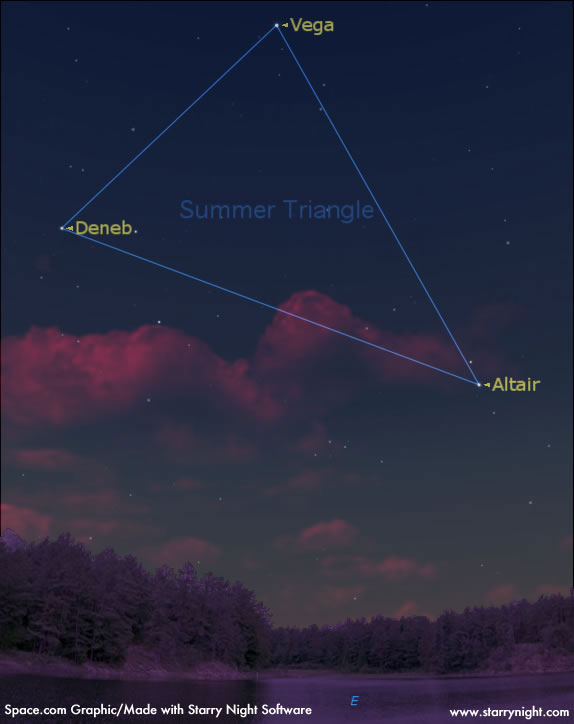
Well up inthe eastern sky during the late-evening hours is the "Summer Triangle,"not a constellation, but a very noteworthy star pattern of the summer skyconsisting of three bright stars from three constellations.
Brightestof the three is Vega,in the constellation of Lyra, the Lyre. Next in brightness is Altair in Aquila, the Eagle. Finally, there is Deneb in Cygnus, the Swan.
To oureyes, Altair appears to shine only half as bright as Vega and Deneb seems onlyone-third as bright as Vega. So at first glance, Vega appears to rule thissection of the sky. In reality, however, a bit of celestial deception is atwork here, for Vega is appears very bright chiefly because of its proximity tous. Vega is 25 light-years away, so when you are looking at it tonight, you arereally seeing it as it was back in 1982.
Altair is17 light-years away, closer than Vega, yet appearing somewhat dimmer. That tellsus that in terms of overall luminosity between the two, Vega is indeed thebrighter star: it is 48 times brighter than our sun, while Altair is only 12times brighter.
A truegiant
But whatabout the third star in the triangle, Deneb? Here, there is no comparisonbetween either Altair or even Vega, for Deneb is one of the greatest supergiantstars known. It shines about 80,000 times brighter than our sun, but because ofits vast distance from us – 1,467 light-years away – it appears as just afairly conspicuous but by no means noteworthy star.
If it weresomehow possible to move Deneb to Vega's distance from us, it would then appearto shine 16 times brighter than Venus is now, and capable of casting distinctshadows and be visible even in the daytime. Conversely, if we were to move Vegaout to where Deneb is, it would shine only as bright as a ninth-magnitude star;you would need a star atlas to precisely locate it, and it would only bevisible in good binoculars or a telescope.
Get the Space.com Newsletter
Breaking space news, the latest updates on rocket launches, skywatching events and more!
With the bright moon now pretty much out of the evening skythis week, there is no better time than now to observe the beautiful summerMilky Way. With a good pair of binoculars or a telescope you can now observemillions of sparkling little stars that make up this glowing, irregular belt ofluminosity. It appears to arch from the north-northeast to the south-southeast,with its brightest and most spectacular region running across the SummerTriangle and beyond toward the south-southeast horizon.
There appears to be a great black rift (sometimes called the"bifurcation") dividing it into two streams, beginning with Cygnusand extending down toward the south. Also in Cygnus is the black void known asthe Northern Coal Sack. This Coal Sack and the Rift are not holes in the MilkyWay, but rather are vast clouds of dust drifting in interstellar space which,from our Earthly perspective, presents a solid and impenetrable curtain betweenus and the more distant stars.
Stuff of legends
There have been many stories, myths and legends told aboutthe Milky Way in many different cultures.
This particular weekend, the Milky Way involves a poignantJapanese legend. The star Vega represented Orihime, whoproduced brilliantly colored fabrics. Across the "Heavenly River" (the Milky Way), Altair represented the cowherd Kengyu. After meeting each otherthey received divine permission to marry, whereupon both abandoned theiroccupations. This angered the gods who separated them and sent them back totheir original jobs on opposite sides of the heavenly river. The couplehowever, received permission from the gods to get together for one night eachyear.
That special night is July 7 – but only if the sky is clear!
As a result, the evening of July 7 has evolved into ayoung-people's holiday in Japan called Tanabata. Prayers are then offered forclear skies so that Orihime and Kengyu, the star-crossed lovers can bereunited. One popular Tanabata custom is to write one's wishes on a piece ofpaper, and hang that piece of paper on a specially erected bamboo tree, in thehope that the wishes come true.
- Online Sky Maps and More
- Sky Calendar& Moon Phases
- Astrophotography101
Joe Rao serves as an instructor and guest lecturer at New York's Hayden Planetarium. He writes about astronomy for The New York Times and otherpublications, and he is also an on-camera meteorologist for News 12 Westchester, New York.
Join our Space Forums to keep talking space on the latest missions, night sky and more! And if you have a news tip, correction or comment, let us know at: community@space.com.

Joe Rao is Space.com's skywatching columnist, as well as a veteran meteorologist and eclipse chaser who also serves as an instructor and guest lecturer at New York's Hayden Planetarium. He writes about astronomy for Natural History magazine, Sky & Telescope and other publications. Joe is an 8-time Emmy-nominated meteorologist who served the Putnam Valley region of New York for over 21 years. You can find him on Twitter and YouTube tracking lunar and solar eclipses, meteor showers and more. To find out Joe's latest project, visit him on Twitter.









